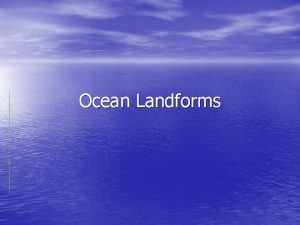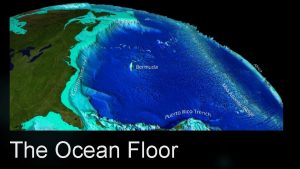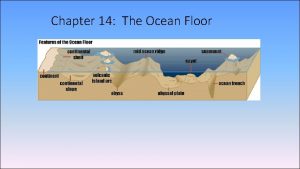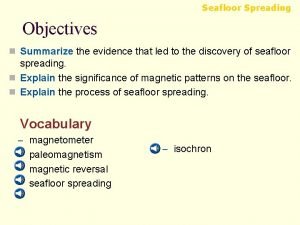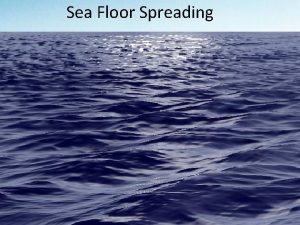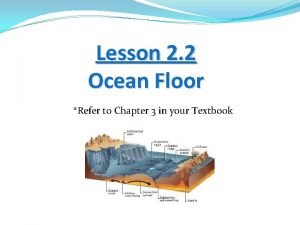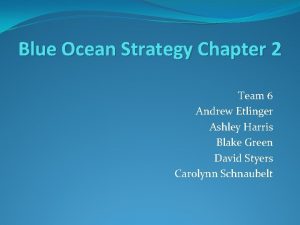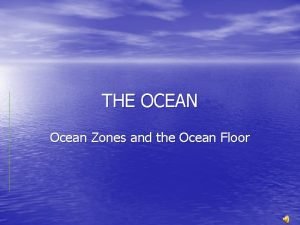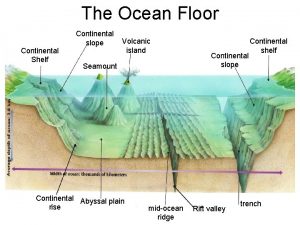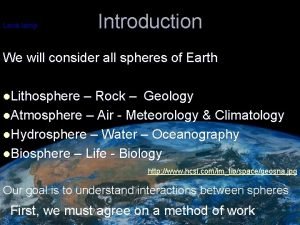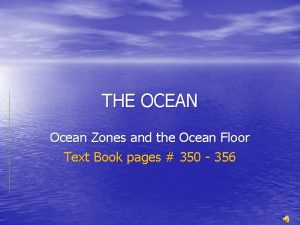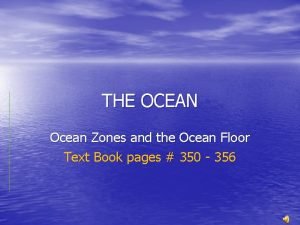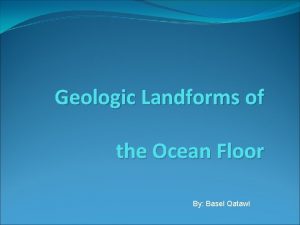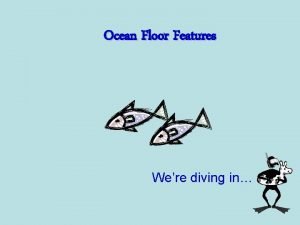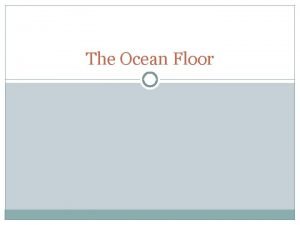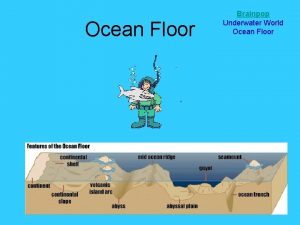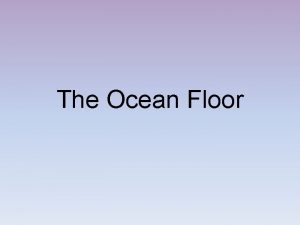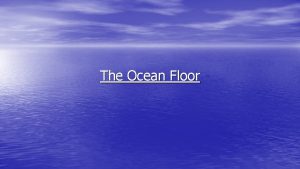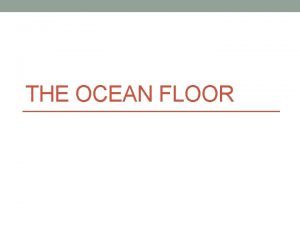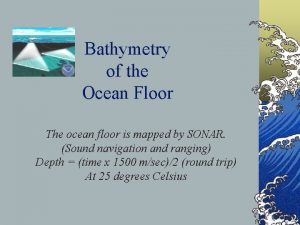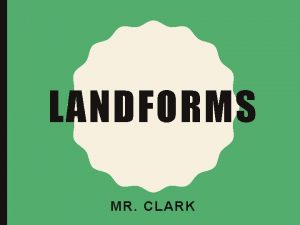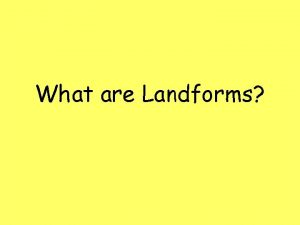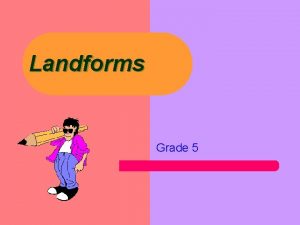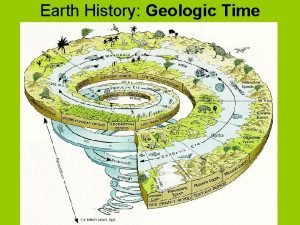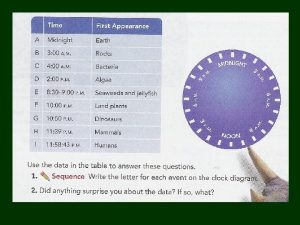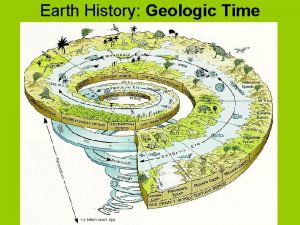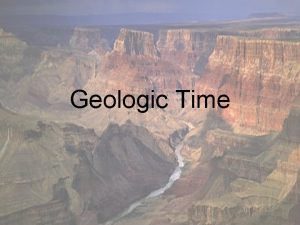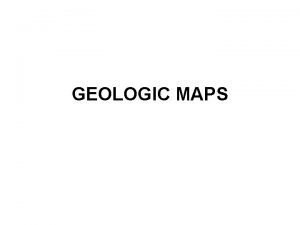Ocean Floor What are the geologic landforms on






















- Slides: 22

Ocean Floor

What are the geologic landforms on the continent? When you think of landforms, you might think of mountains or valleys. These are continental landforms, or landforms on the continents. Landforms are also found under the ocean’s water. These are called oceanic landforms.

Plains • Plains are large flat areas of land that are relatively low. A plain found in the ocean is called an abyssal plain. The Central United States has the Great Plains as shown below.

Mountains and Hills • A mountain has high elevations with steep sides and pointed tops. The top of the mountain is a peak, or summit. • A hill is similar to a mountain but it has a lower elevation. It is usually rounded but not as high as a mountain.

Valleys • Valleys are low, narrow areas on Earth’s crust. On land, valleys are usually formed by erosion. • Valleys in the ocean are called a rift zone, or rift valley. These are formed when the plate boundaries move apart from each other.

Canyon and Trenches • A canyon has steep, rocky walls and is usually formed by water erosion like the Grand Canyon. • Ocean trenches have a much lower elevation than the surrounding area and is caused by one plate sliding under another plate.

Mt. St. Helens Washington A volcano is a mountain that opens downward to a pool of molten rock below the surface of the earth. When pressure builds up, eruptions occur. Gases and rock shoot up through the opening and spill over or fill the air with lava fragments. Eruptions can cause lateral blasts, lava flows, hot ash flows, mudslides, avalanches, falling ash and floods. Volcano eruptions have been known to knock down entire forests. An erupting volcano can trigger tsunamis, flashfloods, earthquakes, mudflows and rockfalls.

Seamounts Volcanic cone shaped peaks that dot the ocean floor are called seamounts. Most are found in the Pacific Ocean. Most seamounts began life as volcanoes formed over hot spots in the ocean floor

Continental vs. Oceanic Landforms • Canyon • Valley • Volcano • Mountain range • Low hills or plains • Trench • Rift • Seamount • Mid-ocean ridge • Ocean basin and abyssal plains

What are the landforms on the ocean floor? The amazing ocean floor is made up of three parts: • the continental shelf • the continental slope • the deep blue sea

Continental Shelf The edges of the continents slope down from the shore into the ocean. The part of the continent located under the water is the continental shelf. In some places the shelf is fairly shallow and in other places it becomes very deep.

The steep slope where the continental shelf drops to the bottom of the ocean floor is called the continental slope. The depth of the water increases greatly here.

Mid-Ocean Ridge On the bottom of the ocean, there is a central ridge, or mountain range, that divides the ocean floor into two parts. These underwater volcanic mountains are the mid-ocean ridge. DID YOU KNOW? The Earth’s largest mountain range is underwater.

Trenches The many steep-sided canyons and deep, narrow valleys in the bottom of the ocean are trenches. Ocean trenches are the deepest part of the ocean basin and are deeper than any valley found on land.

Did you Know? The Marianas Trench in the Pacific Ocean is the deepest trench in the world. It is nearly 7 miles (ll kilometers) below sea level. Mount Everest is only 5. 5 miles (9 kilometers) above sea level.

• The deep ocean basin, • which is about 2. 5 to 3. 5 miles deep, covers 30 % of Earth's surface and has features, such as abyssal plains, deep-sea trenches and seamounts. The abyssal plain is the flat, deep ocean floor. It is almost featureless because a thick layer of sediment covers the hills and valleys of the ocean floor below it.

How can we classify and illustrate natural processes as constructive or destructive? Constructive – Processes that create landforms Destructive – Processes that destroy landforms

Natural Processes that can affect Earth’s oceans and landforms include: • Weathering – a term used to describe processes that break down rocks at or near the surface of the earth. Water is an important cause of weathering. Anything that causes rocks to wear down or break apart is a cause of weathering. • Erosion – the movement of sediments and soil by wind, water, and gravity

• Deposition – the dropping, or depositing, of sediments by water, wind, or ice. Deposition builds up new land on Earth’s surface, like a delta at the end of a river or the pile up of a sand dune in a desert. Shells on the beach are deposition by ocean waves. • Landslides – mass movements of land due to gravity. Landslides can cause buildings to fall, or power and gas lines to break. Landslides even occur on the continental slope in the ocean.

• Volcanic Eruptions – Volcanoes can change the • • Earth’s surface. When the magma erupts from the volcano, the top of the mountain can be changed. The lava and ash can destroy forests and bury fields. Eruptions can even change weather patterns. Earthquakes – vibrations on the surface of the Earth caused by sudden movement in Earth, often along a fault line. Large earthquakes can cause landslides. Earthquakes under the ocean cause huge waves, called tsunamis that destroy land cause great damage on shore. Floods – rapid erosion can take place and move soil and sediments away. When the flood recedes, new sediment is left behind and can build up rich soil deposits.

“What am I? ” Riddle Book You need to create a riddle book from your continental landform terms. You will create a book with a cover (your name needs to be in the top right hand corner), and a page for each term. Each page will have a riddle (one for each term), with the answer on the back of that page.

Oceanic Landform Picto-Cards You will create seven picto-cards, one for each oceanic landform listed on your matrix. On one side of the card you will draw a picture of the landform. On the flip side you will write the term and its definition, then your choice of an analogy or a sentence.
 Compare geologic time with the geologic column.
Compare geologic time with the geologic column. Antigentest åre
Antigentest åre Ocean landforms
Ocean landforms Ocean ocean convergent boundary
Ocean ocean convergent boundary Blue ocean strategy canvas
Blue ocean strategy canvas Convergent boundary feature
Convergent boundary feature Chapter 15 ocean water and ocean life answer key
Chapter 15 ocean water and ocean life answer key Ocean ocean convergent boundary
Ocean ocean convergent boundary Crack watc
Crack watc Convergent boundary
Convergent boundary Convergent oceanic oceanic plate boundary
Convergent oceanic oceanic plate boundary Ocean floor
Ocean floor Chapter 14 the ocean floor answer key
Chapter 14 the ocean floor answer key What is seafloor spreading? *
What is seafloor spreading? * What is sea-floor spreading? *
What is sea-floor spreading? * What is sea-floor spreading? *
What is sea-floor spreading? * Bathygraphic features
Bathygraphic features Blue ocean floor
Blue ocean floor Smooth nearly flat region of the ocean floor
Smooth nearly flat region of the ocean floor Continental rise
Continental rise Ocean floor lava lamp
Ocean floor lava lamp Ocean floor
Ocean floor Smooth nearly flat region of the ocean floor
Smooth nearly flat region of the ocean floor


